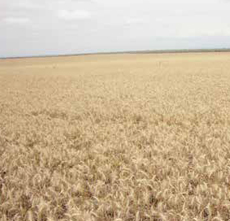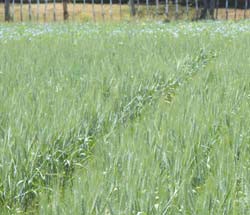Post-Harvest Wheat Management in the Face of Climate Change
Post-harvest wheat management includes activities such as harvesting, drying, storage, and transportation, all of which can be influenced by climate change in various ways.
 Climate change is one of the most pressing challenges of our time, and its impacts are being felt across the globe. As a climatesensitive sector, agriculture is particularly vulnerable to the changing climate. Wheat, one of the world’s most important staple crops, faces significant challenges in the post-harvest phase as a result of climate change.
Climate change is one of the most pressing challenges of our time, and its impacts are being felt across the globe. As a climatesensitive sector, agriculture is particularly vulnerable to the changing climate. Wheat, one of the world’s most important staple crops, faces significant challenges in the post-harvest phase as a result of climate change.
The Impact of Climate Change on Wheat Production
Wheat is a vital source of food for billions of people worldwide. It is grown in a wide range of climatic conditions, making it susceptible to the effects of climate change.
The impacts of climate change on wheat production are multifaceted:
1. Changing Temperature Patterns
Rising global temperatures can affect wheat yields in several ways. High temperatures during the grain-filling period can reduce the number of grains per spike, resulting in lower yields. Additionally, extreme heat events can lead to heat stress, affecting wheat quality and reducing grain protein content.
2. Altered Precipitation Patterns
Changes in precipitation patterns, including increased variability and more frequent droughts, can negatively impact wheat production. Drought stress during critical growth stages can lead to yield losses and poor grain quality.
3. Increased Pests and Diseases
Climate change can create more favorable conditions for pests and diseases that affect wheat. Warmer temperatures can lead to the proliferation of pests like aphids and the expansion of disease ranges, such as Fusarium head blight and wheat rusts.
4. Water Scarcity
In many regions, water scarcity is exacerbated by climate change, posing a significant challenge to wheat production. Reduced water availability can lead to decreased irrigation capacity, affecting crop health and yields.
 5. Extreme Weather Events
5. Extreme Weather Events
Climate change increases the frequency and intensity of extreme weather events like storms and heavy rainfall. These events can lead to lodging (when wheat plants bend or break due to strong winds or heavy rain), which can result in yield losses.
Post-Harvest Challenges
While the focus of climate change discussions often revolves around the impact on crop growth and development, it’s equally important to consider the challenges that arise in the postharvest phase of wheat production.
1. Harvest Timing
Climate change can affect the optimal timing for wheat harvest. Rising temperatures may accelerate wheat maturation, leading to shorter growth cycles. Farmers must adapt their harvesting schedules to ensure that wheat is harvested at the right stage of maturity to maintain quality.
2. Drying
Proper drying is crucial to reduce wheat moisture content and prevent mold growth during storage. Climate change can disrupt traditional drying methods due to increased humidity or precipitation, making it necessary to invest in advanced drying technology or facilities.
3. Storage
Warmer temperatures can increase the risk of insect infestations and fungal growth in stored wheat. Improved ventilation and pest control measures are necessary to maintain grain quality. Climate-resilient storage solutions, such as hermetic storage bags, can also help protect the crop.
4. Transportation
Extreme weather events, including heavy rains and flooding, can disrupt transportation routes and infrastructure. Developing resilient transportation systems and supply chains is essential to prevent delays and losses during transit.
Adaptation Strategies for Post-Harvest Wheat Management
To address the challenges posed by climate change in post-harvest wheat management, a combination of adaptation and mitigation strategies is required:
1. Improved Weather Forecasting
Enhanced weather forecasting and early warning systems can help farmers plan their harvest and post-harvest activities more effectively. Timely information on weather patterns, including rainfall, temperature, and humidity, can inform decisions about drying and storage.
2. Infrastructure Investments
Investing in infrastructure upgrades is essential to adapt to changing climate conditions. This includes modernizing grain drying facilities, improving storage structures, and fortifying transportation networks to withstand extreme weather events.
3. Climate-Resilient Storage Solutions
Farmers can adopt climate-resilient storage solutions like hermetic storage bags, which create airtight conditions to prevent insect infestations and mold growth. These bags are particularly effective in regions prone to high humidity.
4. Sustainable Practices
Implementing sustainable agricultural practices can help build resilience to climate change. Conservation agriculture, which promotes minimal soil disturbance and crop residue retention, can improve soil health and reduce the impacts of extreme weather events.
5. Crop Diversification
Diversifying crop production by integrating wheat with other climate-resilient crops can help reduce the overall risk to farmers. Crop rotation can also break the cycle of pests and diseases that may affect wheat.
6. Research and Innovation
Continued research and innovation in wheat breeding are essential to develop climateresilient wheat varieties that can withstand the changing conditions. These varieties should have improved heat and drought tolerance, as well as resistance to pests and diseases.
7. Knowledge Sharing
Education and knowledge sharing among farmers and agricultural extension services are crucial for the successful implementation of adaptation strategies. Farmers need access to information and training on climate-smart practices.
Mitigation Efforts
While adaptation is crucial, mitigation efforts to address the root causes of climate change should not be overlooked. Reducing greenhouse gas emissions from agriculture, such as methane from rice paddies and nitrous oxide from fertilizer use, can contribute to a more sustainable future for wheat production.
Implementing precision agriculture practices, optimizing fertilizer use, and reducing post-harvest food waste can all help lower the carbon footprint of wheat production.
All in all, Climate change poses significant challenges to wheat production, from the field to postharvest management. To address these challenges, farmers, researchers, and policymakers must work together to implement adaptation and mitigation strategies.
Additionally, efforts to reduce greenhouse gas emissions from agriculture can contribute to a more sustainable and resilient food system in the face of climate change. By taking action now, we can protect global food security and support the livelihoods of millions of farmers who depend on wheat production.